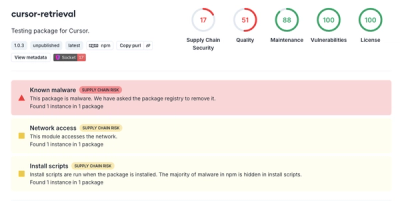
Security News
The Risks of Misguided Research in Supply Chain Security
Snyk's use of malicious npm packages for research raises ethical concerns, highlighting risks in public deployment, data exfiltration, and unauthorized testing.
@highlight-ui/toggle-input
Advanced tools
The ToggleInput is used to control the shared logic between the Checkbox and RadioButton components.
For this reason, we refer you to the documentation of these two components and we do not recommend the custom use of this component.
Using npm:
npm install @highlight-ui/toggle-input
Using yarn:
yarn add @highlight-ui/toggle-input
Using pnpm:
pnpm install @highlight-ui/toggle-input
In your (S)CSS file:
@import url('@highlight-ui/toggle-input');
Once the package is installed, you can import the library:
import { ToggleInput } from '@highlight-ui/toggle-input';
If you're interested in contributing, please visit our contribution page.
FAQs
The base component handling Checkbox and RadioButton logic.
The npm package @highlight-ui/toggle-input receives a total of 303 weekly downloads. As such, @highlight-ui/toggle-input popularity was classified as not popular.
We found that @highlight-ui/toggle-input demonstrated a healthy version release cadence and project activity because the last version was released less than a year ago. It has 0 open source maintainers collaborating on the project.
Did you know?

Socket for GitHub automatically highlights issues in each pull request and monitors the health of all your open source dependencies. Discover the contents of your packages and block harmful activity before you install or update your dependencies.

Security News
Snyk's use of malicious npm packages for research raises ethical concerns, highlighting risks in public deployment, data exfiltration, and unauthorized testing.

Research
Security News
Socket researchers found several malicious npm packages typosquatting Chalk and Chokidar, targeting Node.js developers with kill switches and data theft.

Security News
pnpm 10 blocks lifecycle scripts by default to improve security, addressing supply chain attack risks but sparking debate over compatibility and workflow changes.